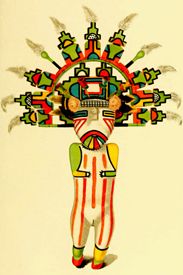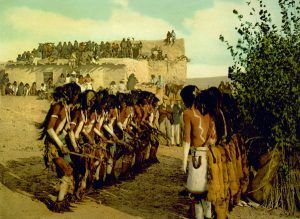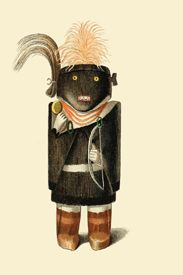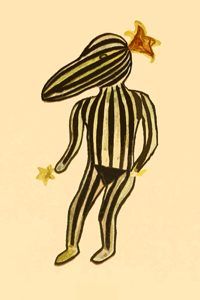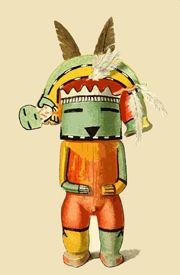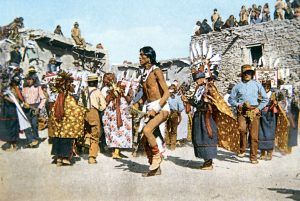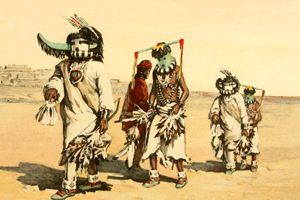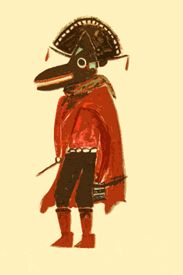
Natacka Naamu – Ogre Father Kachina
Ogre – There are both Black and white Ogre kachinas. The White Ogre, called Wiharu, represents good; while the Black Ogre, called Nata-aska, threatens small children who are naughty. Both ogres usually carry a saw or knife, as well as a bow and arrows for hunting. Their most noticeable feature is their long, chomping jaws, which are often clacking. These Ogres will accompany Soyoko (Ogre Woman) on her trip to collect food from the children and make certain they help with chores and growing corn. As a means of discipline, children are told the ogres can swallow them whole.
Ogre Man – Known as Awatovi, this ogre kachina is believed to originate from the destroyed town of Awatovi. Seldom impersonated, when he does he performs similar functions as other ogres, like standing beside the Ogre Woman, and putting food he has gathered from the villagers into his basket. During the actions of the Ogre Woman, he stands by her side, while stomping and grumbling to scare the children. He usually wears a black breechclout rather than an embroidered kilt and his calves and forearms are often covered with black or red spots.
Ogre Woman – Known as Soyoko, this kachina has a hideous appearance and is equipped with cleavers and saws with the purpose of disciplining naughty children. Upon a parent’s request, several of these ogre figures appear at the home of the naughty child. They demand impossible tasks of the children, warning them they will be back to check on them in several days. This Monster Woman appears during the Powamu ceremony dressed all in black, with long straggling hair, staring eyes and a wide-fanged mouth. When she speaks, it is in a wailing falsetto or with a long dismal hoot of ‘Soyokó-u-u-u.’ from which her name is derived. She may reach for the children with the long crook and threaten to put them in the basket on her back, or to cut off their heads with the large knife that she carries in her hand utterly terrifying her young audience. In some villages she leads the procession of ogres; in others, she remains at the side, content to make threatening gestures.
Old Man – Known as Wuwuyomo grandfather Kachina is called Old Man because he is very ancient. He may also be known as Mong or Chief Kachina and always appears in groups of four the Powamu ceremony singing songs for a successful growing season.
Owl – Symbolizing intelligence and wisdom, this kachina is beneficial to agriculture because of his destruction to rodents.
Pachavuin Mana – Also known as the female Hemis Kachin Mana, this Hopi kachina is truly a woman. She brings the beans sprouts, artificial corn, corn sprouts and grass to the village harvest. The crowd is usually lead by Chief Kachinas and Village Chiefs to perform certain rites and wait for the given signal to leave.
Paralyzed – Known as Tuhavi, this paralyzed kachina is carried by a friend who was blind, together they were able to complete each other’s needs and hunt and travel. The blind man is a Mud Head (Koyemsi) who becomes the Paralyzed Kachina’s legs, and the Paralyzed Kachina becomes the Mud Head’s eyes. They appear together in the Mixed Dance.
Piptuka – This kachina appears in public dances and is a participant in the antics of the mudheads or clowns. He carries a hoe over his shoulder and a planting stick in his left hand, indicating his connection with planting.
Parrot – Called Kyash this kachina disappeared in the early years of its history but reappeared again around 1965. It has been given dances in the Water Serpent Ceremony and the Line Dance. The purpose of this kachina is to bring summer growth and attract more parrots.
Prickly Pear Leaf – Known as Navuk-china, this is an old Kachina who appears in the Mixed dances. The cactus that he represents was used as food by the Hopi in the past. He is sometimes accompanied by his sister kachina Navuk-chin Mana, the Snow Maiden.
Priest Killer – No one knows for sure exactly what the Priest Killer story is, but it is believed that he appeared around the time that the Spanish came to the Hopi people. When the Spaniards came they tried to preach their religion to the Hopi, who eventually revolted and started burning churches that the Spaniards had built and killing any priest who would not leave. The story can be told slightly differently in almost every village.
Quail – Called Kawaspi, this is one of the several bird spirits and appears as a runner. Animals are teachers, advisors, and doctors to the Hopi people.
Rainbow – This kachina represents peace and harmony throughout the tribes.
Ram – Much like all game animals, this kachina dances increase its kind and has power over the rain.
Red Bearded – Known as Tawa Angak’china, this is one of the most favored kachinas among the Hopi. They are appreciated because of the melodious songs and the beautiful dances that they do in the spring. The main purpose of the Angak’china is to bring rain to the people and their crops. Their long hair, which is worn loosely down the back, resembles the falling rain with the eagle breast plumes rising like clouds above it. These kachinas appear in the Niman Ceremony.
Red Skirt Runner – Called Palavikuna this kachina carries yucca whips, as do most of the runner Kachinas, and he also offers piki bread as a reward to those who beat him in a race.
Red-Tailed Hawk – Known as Palkwayo, this kachina is a warrior, hunter and Chief Kachina. Though rarely seen this kachina and having almost disappeared in some villages, he serves many important purposes. He appears in the Pachavu ceremony/
Road Runner – Known as Hospoa, this kachina assists in bringing rain, wards off witchcraft to protect homes, and works to attract more road runners. He usually appears in the Mixed Dance or Kiva Dance.
Scavenger – A rare figure that depicts a looter from the ruins of Awatowi. After the war in Awatowi, the scavenger went around picking up any worthy things left behind. He accompanies the Ogre Woman during ceremonies and after she has received all of the things she wants, he picks up everything else that would not fit into her basket. He is believed by some to be a part of the Ogre family.
Scorpion – Known as Puchkofmoktaka, this horned runner is a comical spirit. Running races during ceremonial games, he carries two sticks in hand and is known to launch one of these at a competitor that is ahead in the race.
Screech Owl – Known as Hotsko this kachina is one of the many birds that participate in the Kiva Dances of the Powamu. He is a hunter who has evolved, according to stories, from a hunter of wild animals to a hunter who threatens the domestic barn animals of farmers. This Owl and animals in general, are very important to the Hopi people as teachers, advisors, and doctors.
Shalako Mana – Also called Calako Mana and Giant Cloud Maiden is a Zuni kachina that towers seven or eight feet and usually appears with its mate. The Shalako, who are believed to have first arrived at Zuni around 1840 are the God’s messengers and run back and forth all year long carrying messages, as well as bringing moisture and rain when needed. The Shalako Ceremony is performed in late November or early December and takes place after the crops are in. This ceremony is the most important event of the year for the Zuni Indians of New Mexico. These kachinas ask for rain, the propagation of plants and animals, and the health and well being of its participants.
Shulawitsi – This Zuni Fire God is almost an exact duplicate of the Hopi Kokosori, but he is not related to Kokosori. A young boy who is innocent and pure of heart usually performs him. He carries a fire stick, signifying his responsibility as a caretaker of one of the important physical elements of the universe fire. Performing at the Shalako ceremony, his body and mask are painted black with various multicolored dots. He also carries a small deerskin bag within which are seeds to be blessed during the fertility rites that are a part of the Shalako ceremony that ends one year and begins another.
Sio Shalako – This kachina appears at Powamuya ceremony, or “Bean Dance”, which occurs during the latter days of January through February, when the Hopi appeal to the Kachinas for fertility and abundant crops. At this ceremony young boys are initiated into the kachina cults or the religious life of the Hopi people. A rain kachina, he was introduced to the Hopi from the Zuni in about 1850.
Snake Dancer – Known as Chusona the Snake Dancer is not a kachina but rather a society personage. He appears at late summer dances and performs with a snake in his mouth. The dancers enter the Snake House to retrieve the snakes for the dance. It has always had an intense fascination for the non-Hopi and therefore, its effigies had been carved for many years..
Snow Kachina – The Snow Kachina is a favorite character during the winter months. Because he lives on top of the San Francisco Peaks he is credited with bringing the cold and snows to the Hopis. This winter moisture is absolutely essential for the growth of the crops.
Snow Maiden – Known as Nuvak’chin Mana, this kachina brings blessings, snow and cold weather which are essential to the growth of crops. She is seen during the Niman Ceremony.
Soyok Mana – One of several women ogres, who along with Soyok Wuhti (Monster Woman), visit the houses in the villages during the Powamu ceremony. During their visits, they threaten children who have misbehaved and ask for food. They either whistle their disapproval of or accept the food which is put in their baskets and taken to the kivas.
Soyok Wuqti or Natacka Wuqti – (Monster Woman) The name Soyok is applied to certain monsters called Natackas, which appear in the Powamu ceremony. These kachinas are thought to have derived from the eastern pueblos as they are represented at Zuni. Besides the Soyoko or monsters which regularly appear in the Walpi Powamu ceremony, there are other similar monsters that make occasional visits. Soyok Wuqti has a large black mask with great yellow goggle eyes, and red beard and hair, in which is tied a red feather, the symbol of death or war. She carries in one hand, a crook to which several shell rattles are attached, and in the other, a huge knife. She is much feared by the little children, who shudder as she passes through the pueblos and halts to threaten with death those she meets. She appears at Powamu ceremony at about the same time as the Natackas, but does not accompany them.
Soyal Mana – Soyal is a winter solstice ritual designed to turn the sun back in its course. Mana means maiden. This kachina appears along with Ahulani on the morning of the last day of the Soyal Ceremony.
Squash – Known as Patun or Patung this plant kachina like others, is of great importance because of the dependence upon them for food. This kachina is a favorite to many collectors. Among the Hopi, the Patung kachina is a runner from First Mesa but this kachina is originally from Zuni. He is a Chief Kachina in the Pumpkin Clan. Carvers make many versions of this doll and most still follow the basic form of him holding a flower in his right hand and a yucca whip in his left. In the image at right, he wears a mask and body paint of green with black stripes, breechcloth, and carrying squash blossoms.
Spotted Corn – This kachina helps to pollinate corn plants which increases the amount of food available at harvest.
Sun – Called Tawa or Dawa, this kachina symbolizes abundance, life, growth, and strength of spirit. He comes during the solstice to beckon the sun’s return and begin the growing season. The Sun Kachina usually carries a spruce tree in his left hand and a bell in his right. When he appears in the Mixed Dance he carries a flute in his left hand and is rarely impersonated.
Sunface – Represents warmth, shelter for the old, bright future, and playfulness for the young.
Talawiqpiki – A lightning god with a zigzag symbol of lightning from the rain cloud and rainbow carried over the head.
Tcolawitze – Zuni fire god.
Tecab – This is one of the most common of the Navajo kachinas. This figure has points of symbolism similar to that of Tecab Yebitcai. The image shows the face is painted white with crescents under the eyes and mouth. There is a representation of a stalk of growing corn on the median line of the mask, and an ear of maize on each side. The figure wears a red kilt and black bandoleer and carries yucca whips in his hands.
Tecab Tenebidji – Another common Navajo kachina, this one is personated by the Hopi. The eyes are black, horizontal bands, curved at the outer ends with a long snout. On that side of the head which is turned to the observer there is a symbol of a half-formed squash surrounded by red horsehair, and to the opposite side of the head, are attached two vertical feathers. On the crown of the head are variegated parrot feathers. The red fringe on the forehead represents the hair.
Tecab Yebitcai – The name of this Navajo supernatural is translated to Grandfather kachina and the Hopi say that the Navajo name has a like meaning. The artist has depicted on the mask a stalk of corn on a white face. The eyes and mouth are surrounded by two half rectangles. A conventional ear of corn is painted on the left cheek. There is likewise a crest of eagle feathers on the head. Yebitcai wears a blue calico shirt, black velvet pantaloons, and Navajo leggings. Both the pantaloons and the leggings have a rose of white disks along the outside which represent silver buttons, and he wears a belt of silver disks strung on a leather strap. A buckskin is represented over his right shoulder, and in his left hand, he carries a bow and two arrows, and a skin pouch for a sacred meal.
Turkey – Known as Koyona this kachina dances with the other birds in the kivas at night or during the Mixed Dances of spring. He is from First Mesa and is very rare. Birds or animals in general, are very important in the Hopi culture. Animals are advisors, healers, and hunters to the Hopi people. The Hopi have learned a lot from animals.
Turtle Maiden or Woman – The Turtle Maiden or Kahaila Mana, this maiden, like others, is simply a Kachin Mana, but because it accompanies Kahaila, it also picks up his name. Also, the face of the Mana is painted differently. The Turtle Maiden is very rarely carved into a Kachina. All animals and mammals are an important part of the Hopi culture, they are believed to provide guidance, health, and protection.
Velvet Shirt Navan – The Navan or Velvet Shirt Kachina is a new Kachina. It was introduced in the 1900s to the Hopi culture. He is believed to have come from the village of Moenkopi. Navan usually appears in the Kiva Dances. He is seen wearing ribbons and bright colors. He is a very colorful Kachina. The name Velvet Shirt comes from the shirt he is seen wearing.
Wapamo – See Long-Billed
Warrior Maiden – Called He’e’e or Hehee, this kachina represents a warrior spirit. It can appear as a man dressed in women’s clothes or a woman with a man’s tools. This kachina is a potent warrior and during the Pachavu Ceremony, she leads the group of fearsome warrior kachinas in a battle to protect the line of dancers. Because she is so potent, there are other guards who protect certain ceremonies from her dangerous presence. There is such a close resemblance between her and Teakwaina Mana that they would seem to be the identical personages.
Water Drinking Girl – Called Palhik Mana she is often seen grinding corn, while sometimes she is seen with colorful plants and birds. She brings rain creating life, whether it is corn or animals, and is highly thought of by the Hopi. She is often mistaken for the Poli Mana (butterfly maiden) and the Salako Mana, as their functions are similar.
Warrior Ahote – The Ahote is a hunter that originates from the Plains Indians, but has been adopted into the Hopi culture. He comes in two colors; yellow or blue. His long and trailing eagle’s feather headdress resembles a Plains Indian warrior. The colorful triangular patch with pendant colored circles between the eyes represents the flowers of spring. Ahote appears in the Mixed Dance and the Plaza Dance. Sometimes, he carries a roast or boiled corn to give to the audience during his performance.
Warrior Mouse -The Warrior Mouse Kachina is a central figure in Hopi folktale. He is not a dance figure at all, but rather the hero of a Second Mesa legend. A mouse undertook to rid the village of a pesky chicken hawk. He did that by taunting the hawk and tricking him to dive into a stake and impale himself. The Warrior Mouse, as he is called, is not to be confused with any other folktale mice. The mouse and other animals have always played an important role in Hopi ceremonies and tradition. The Hopi believe that through animals, one can learn many things about life.
Warrior Woman – Known as He Wuhti this kachina can either be a man dressed as a woman or a woman using men’s equipment depending on where you hear the story. For the story of the man, the story states that he did not have enough time to find his clothes when the enemies approached, so he had to wear his bride’s costume to quickly fight them. As for the woman, they say that she was just finishing doing her hair with her mother when she saw the enemies approaching. With only one side of her hair complete, she snatched up her bow and arrow and proceeded to defend her village until the men returned from the field. Despite the differences in stories, the He Wuhti functions as a warrior spirit that leads a band of warrior kachinas to protect the procession of the Pachavu ceremony.
White Bear – Thought to be powerful and capable of curing bad illnesses, these kachinas are great warriors and are usually seen in the Soyohim or Mixed Dances of springtime.
White Cloud – Brings rain for needed food crops and is a representative for the presence of clouds.
White Buffalo Dancer – Called Kocha Mosairu this is not a kachina, but rather a social dancer. It is usually seen in ceremonies in January on First Mesa. It is a doll that most carvers do not mind doing as part of their repertoire. It is now a favorite among collectors. All animals are an important part of the Hopi culture, they are believed to provide guidance, health, and protection.
White Chin – Also called Tuma-uyi this achina is amongst the oldest known Hopi Kachinas around today. He got his name because he has a very colorful face, but his chin is painted white. This Kachina’s main function is unknown. He is now rarely seen in ceremonies.
Wiktcina – This being assists the clowns and amuses the spectators by throwing mud during the dances and festivals. He wears a helmet mask with circular eyes and mouth and appendages.
Witch or Guard – Known as Hilili the origin of this kachina is believed to be from the Zuni Tribe. In the Acoma and Laguna pueblos he is known as Heleleka. His name comes from the call or noise that he makes. When he first came to the Hopi, people were very suspicious of him. He is mainly seen holding Yucca whips. He has become a popular guard at the ceremonies due to his dancing style. He can bee seen in the Powamu and Night dances.
Wolf – Also known as Kweo this kachina is often seen in dances accompanied by the Deer kachina or Mountain Sheep kachina during the Soyohim Dances. He carries a stick that represents the trees and bushes that he uses to hide in whenever he stalks his prey. During ceremonies, the Wolf Kachina’s sharp teeth are always visible along with its lolling tongue. They are made visible to boast the wolf’s prowess as a hunter. After the dance, it is customary for the Hopis to offer the Kweo Kachina cornmeal, and in return, the Kweo Kachina blesses them on their hunt.
Yellow Corn Maiden or Woman – Known as Takursh Mana she appears with Angak’china, Ma’alo, Pawik, and other Kachinas. They dance in a line separate from the other line Kachinas, but following the same pattern of turns and gestures. The Takursh Mana does make one different move. She kneels and places a large gourd on the ground to rasp. She usually carries a scapula and a notched stick, which produces a sound with different tones like a musical instrument.
Wolf – This kachina is a hunter who uses his knowledge to help villages locate and catch needed game animals, making certain that there will be enough food for the coming winter. Highly respected, the Wolf usually shows up at the dance sneaking behind the antelope, deer or rabbits hiding behind his stick which represents trees and cover. Towards the end of dances, he is showered with offerings in hopes that the people may channel his skills as a hunter.
Zuni Chief – Called Pautiwa, this kachina chief summons the Zuni people to the Kachina Village and is the most prestigious of all Zuni deities. Illustrating Zuni virtues of dignity, beauty, leadership, and benevolence, he is concerned for the welfare of all people and kachina spirits. Though he has a role in many Zuni stories and coordinates the Zuni ceremonial calendar, he appears on only three occasions, all during the Winter Solstice rituals. No Kachina may visit the Zuni pueblo of unless Pautiwa approves and sends it. He is a Sun Kachina and a member of the Sun Clan.
Zuni Rain Priest – Accompanies the Shalako to bring rain.
Ceremony Types:
Hakitonmuya – During this period small quantities of beans, pumpkins, gourds, muskmelons, and watermelons are planted. The word “haki” means “wait,” as it is not yet the time to plant most of the crops. Kachinas are called upon to help the plants sprout and grow. Many of them represent seeds and different kinds of sacred corn, or blooming plant life; others represent rain or the increase of game animals. During the early planting season, kachina dances and footraces performed on the plaza.
Kwiyamuya – In April, the Hopi start preparing and planting their gardens and fields with various crops, especially corn. Racer kachinas appear in the plaza and challenge men and boys to foot races, thus blessing them with strong and healthy lives. “As the men race, so the water will rush down the arroyos,” the Hopi say. A Mudhead kachina leads the Racers, carrying prizes in a blanket. During the kwiyamuya races, two kachinas who are female fertility figures force men and boys to the ground and make copulatory movements that symbolize procreation.
Kyaamuya – Also called the Soyalangwu Ceremony, this takes place in December, a sacred month when the gods return and the sun turns back on its way towards summer. The Hopi respectfully prepare for the arrival of the kachinas with storytelling and the Soyalangwu ceremony. The first few kachinas of the new year appear at the beginning of Soyalangwu, the winter solstice ceremony which may last up to nine days. It involves the making of prayer objects, many prayers and rituals, and a rabbit hunt and feast at its conclusion. The prayers and rituals help the Hopi turn the sun toward its summer home and begin giving strength to all life for the growing season ahead. Two kachinas, representing fertility, procreation, and renewal approach females of the village and simulate copulation to symbolize fertilization of the new growing season.
Kwiyamuya – In April, the Hopi start preparing and planting their gardens and fields with various crops, especially corn. Racer kachinas appear in the plaza and challenge men and boys to foot races, thus blessing them with strong and healthy lives. “As the men race, so the water will rush down the arroyos,” the Hopi say. A Mudhead kachina leads the Racers, carrying prizes in a blanket. During the kwiyamuya races, two kachinas who are female fertility figures force men and boys to the ground and make copulatory movements that symbolize procreation.
Niman Ceremony – Also called the Home Dance, this Hopi ceremony is the last appearance of kachinas at Hopi before they depart for their homes in the San Francisco Mountains. This early August event closes the kachina season. The most common masked dancers on this occasion are the Hemis kachinas, although others may appear. In its solemnity, this kachina dance differs from the plaza dances that precede it throughout the spring and summer. No clowns are present.
Osomuya – A cycle of Night Dances called Angk’wa this ritual follows Powamuya and repeat several Powamuya ceremonies. The head of the kachina clan inaugurates them. As with other Night Dances, or Kiva Dances held in winter and early spring, kachinas dressed in ceremonial kilts and sashes climb into the kivas and give people samples of crops that will soon be planted. Their gifts ensure a plentiful harvest. Throughout Osomuya, dances accompanied by drumming and singing are held until dawn in all the kivas.
Paamuya – Following Soyalangwu, these winter social dances are held in homes and the kivas at night, and on the plazas during the day. They last until the beginning of Powamuya ceremony. The dances depict animals that live in the mountains now covered with snow, and are prayers for snow to fall on Hopi fields and for successful hunting.
Pachavu – Serves as a dramatization of historical events.
Plaza Dances – Public kachina dances performed in village plazas during the spring and summer months, culminating a longer series of secret or private rites. These events are sponsored to celebrate a special event and include feasting and socializing, as well as dances that both entertain and enact Hopi religion. The dances are unquestionably religious in character, presenting kachinas and emphasizing fertility, rain, health, and life. These dances are either mixed dances, where each dancer presents a different type of kachina, or line dances, where all the dancers present. Clowns often perform during the dances, especially in the intervals between kachina dance sets. The greater amount of space in the plaza provides room for the long lines of regular dancers and for the more active “side dancers.” These highly skilled “side dancers” encourage the others and emphasize the rhythm of the song and often accompany the words of the songs with gestures. Summer dances are always popular and well attended. The final dance of the year is the “Home Dance” or Niman. It signals the departure of all the Kachinas for their mountain homes. After the “Home Dance” no more Kachinas appear until the following year.
Powamuya – Also called the Bean Dance, the ceremony, taking place in February sees the kachinas arrive in force to help the Hopi prepare for the next growing season and to initiate children into the Kachina Society. The most important kachina ceremony is a series of rituals that promote fertility, germination, and early growth of seeds. It also initiates children between six- and ten-years-old into the Powamuya Society. The children are then allowed to participate in kachina performances.
One important event during Powamuya is the planting of beans. Within the kiva, men under the supervision of Powamuya officers plant 50 to 100 beans in a bucket filled with earth. A fire is kept going day and night to help the beans grow. Patsavu Hu´ kachinas regularly inspect the plants. The planting and growth of the beans inside the warm kiva are seen as a good omen for the success of the coming harvest. On the 16th day, the kachinas give away mature bean sprouts in a public ceremony followed by a procession of many kachinas who dance and give away dolls, dancing wands, decorative plaques, bows and arrows, lightning sticks, rattles, and moccasins. Among the dancers are Ogre kachinas who frighten children into behaving properly. Eototo, who is considered the spiritual chief of the village, appears for the Powamuya ceremony. Eototo controls the seasons and uses cornflower to attract moisture and clouds into the pueblo. During the ceremonial dances and sacrifices, Eototo promises to provide food and water to the Hopi.
Shalako Ceremony – This Zuni ritual taking place on or about December 1, is a sacred drama, enacted in the open for the double purpose of invoking the divine blessing upon certain newly built houses, and of rendering thanks to the gods for the harvests of the year.
Soyal Dance – Soyal is a winter solstice ritual designed to turn the sun back in its course. Combined with this may be a ritual in which medicine is prepared and either drunk or rubbed on the body to promote health and strength. The first kachina to appear, thereby opening the kachina season, is Soyal, a shabbily dressed figure who totters along in the movements of an old man. He makes his way to kivas, placing prayer feathers and sprinkling cornmeal. Other Soyal actions include the preparation of prayer feathers for relatives, crops, animals, houses, cars, and personal well-being. The period beginning with the winter solstice and lasting until a few weeks past the summer solstice is distinguished by the frequent appearance of kachinas, masked messenger spirit beings.
Soyohim Ceremony – Held in the Spring, this is a rain dance, with each dancer dressed in characteristic apparel and masks of different kachinas. In this arid country, the great and unceasing prayer is for rain to water the crops. The Soyohim kachina includes numerous varieties including the Rain Cloud, the Owl, the Apache, the Navaho, the Shalako, and more.
Talangva – This ceremony takes place in July when all the previous kachina rituals and dances culminate in the Niman ceremony. Shortly after the summer solstice, the 16-day Niman ceremony celebrates the departure of the kachinas to their spirit world in the San Francisco mountains. After eight days of sacred activities in the kivas, the kachinas perform a public dance. They enter the plaza at sunrise with their arms full of the first green corn stalks of the year, thus demonstrating that corn will be plentiful. They also bring presents, including dolls, for the children. Toward the end of the evening, they reenter the kiva, where an altar has been set up. There they dance for the last time and receive offerings. The father of the kachinas gives a farewell speech, thanking them for past favors and praying for their continued help. He then sprinkles them with cornmeal and spreads cornmeal on a path for them to follow to the west. The kachinas slowly leave to return to the gods with the Hopi’s gifts and prayers.
Wuko’uyis – Held in early June, the main planting season, an important time when the first corn, a sacred crop, is planted and young people and children are taught how to farm. Corn is used in the making of dietary staples like bread and cornmeal. Cornmeal is often used to thicken other dishes, and corn husks were historically used to create sleeping mats, baskets, dolls and more. During this time kachinas appear at sunrise in all twelve Hopi villages and proceed in a single file to the plazas. The dances conclude at sunset with prayers and blessings. The kachinas also travel through the Hopi villages with gifts of food.
Compiled and edited by Kathy Weiser/Legends of America, updated November 2019.
See our Kachina Photo Gallery HERE
Also See:
Ancient & Modern Pueblos – Oldest Cites in the U.S.
Ancient Cities of Native Americans
Sources:
American Bureau of Ethnology, Annual Reports, Volume 21, 1899
American Indian Originals
American.net
Andrews, Tamra, Dictionary of Nature Myths: Legends of the Earth, Sea, and Sky, Oxford University, 2000
Aurora University
Cameron Trading Post
Harvard University
Heard Museum
Hopi Kachina Dolls
Indian Summer
Kachina House
Kachina Dolls
Kachina US
Palms Trading
Pueblo Direc
Santa Fe at Home
Southwest Crossroads
Tyler, Hamilton A.; Pueblo Gods and Myths, University of Oklahoma Press, 1972
University of California Press
Wikipedia
Wildertupia

